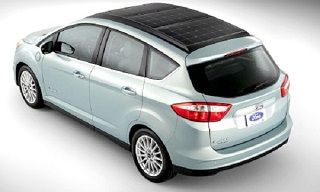Solar PV on Your Electric Vehicle’s Roof

On a sunny day and under optimum driving conditions, I’m guessing drivers may get two or three extra kilowatt-hours, sufficient to drive another 10 – 15 miles. Not too bad.

On a sunny day and under optimum driving conditions, I’m guessing drivers may get two or three extra kilowatt-hours, sufficient to drive another 10 – 15 miles. Not too bad.
Craig,
As always, I’m going to have to be the downer on this party… But Fueleconomy.gov rates the Ford Focus Electric at 32 kWh/100 miles, or ~3.125 miles/kWh.
We agree on the power derived from the unit… it’s possible that the panels might have a basic efficiency of ~10-12%% (they won’t be industry leading efficiency – they’ll have to be extremely secure for both wind resistance and vibration). The roof of a boxy mini-hatchback might have ~2.5-3 m3 of space, so your estimate of ~2-3 kWh matches well for a sunny region.
However, if the car only gets 3.125 miles/kWh, that’s good for 6-9 miles of driving, max. I cannot see this estimate increasing, as a smaller car (necessary for better fuel economy) would have a smaller area of rooftop.
So you have a possibility of saving at most a single gallon of gasoline every 4-5 days of driving, or ~50 gallons a year. A 15-year longevity for the car would save a total of ~$2500, and ~10 tons of CO2.
If you assume that an average investment in a wind farm would yield ~5% (a VERY low estimate), then you would only have to invest ~$1200 in a wind farm in order to exceed the total savings seen in fuel costs… and such an investment in a wind farm would have a net impact of reducing CO2 emissions by ~80 tons.
So the question is: how much does the optional solar system cost? When Toyota tried this gimmick, the solar roof costed ~$10,000 (that was an even worse payoff – it just kept the AC running for you on hot days, saving only a few gallons of gasoline/year). What do you suspect Ford’s price point will be on this?
Fair points. And good question at the end. I have no idea. I would think they would want to make it very attractive, so most car-buyers accept the option, and Ford becomes more visible in the EV space.
Btw, there are other minor benefits associated with the product: Tangible (slightly better range) and intangible (psychological — “I’m using the sun!”).
I agree with Glenn, although I think both of your calculations are high, mainly because there is no way a car’s solar panels will be oriented properly, so they will have a low capacity factor. Over the course of a year, I’d expect no more than 1 kWh/day, even for someone who always parks in full sun.
On the other hand, I agree with Craig that this is all about the sales pitch and perception. If car buyers paid attention to economics or true greenery, we’d all be driving 2nd-hand compact cars. Or taking the bus.
For typical efficiency, you get about 150w/sq meter, and the usable surface area of a car is no more than 3 square meters. Assume a normal 15% capacity factor and you get:
150 w/m^2 / 1 kw/1000 w x 3 m^2 x 24 h / day x 15% = 0.72 kWh/day. Optimistically you can drive 3 miles/day on that… unless you park in the shade!
Tom,
Our calculators don’t agree… I was indeed assuming a higher cf, but if you take:
the following equation: 0.15 * 3 * 24 *0.15 = x. you get x = 1.62.
You’re probably right that the vehicle would get much lower cf than I assumed, but in Ford’s promotional information they say they incorporate tracking, and that it’s a concentrated PV cell… so I was giving them the benefit of the doubt and giving a range of optimistic cf values – again for sunny regions only.
🙂
I wasn’t arguing whether or not it would sell… I have no idea whether it would sell… I just questioned the overall value it provided vs the cost. My guess (and it’s just a guess) is that it will add at least $6000 to the MSRP, and it will not possibly add that much value, either in economic returns or environmental returns.